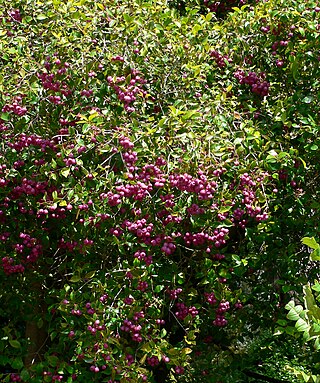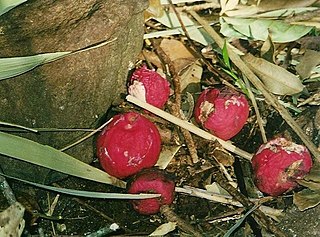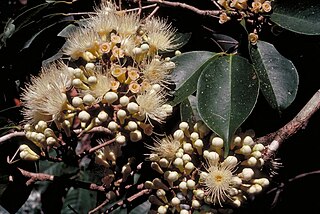
Myrtaceae, the myrtle family, is a family of dicotyledonous plants placed within the order Myrtales. Myrtle, pōhutukawa, bay rum tree, clove, guava, acca (feijoa), allspice, and eucalyptus are some notable members of this group. All species are woody, contain essential oils, and have flower parts in multiples of four or five. The leaves are evergreen, alternate to mostly opposite, simple, and usually entire. The flowers have a base number of five petals, though in several genera, the petals are minute or absent. The stamens are usually very conspicuous, brightly coloured, and numerous.

Syzygium is a genus of flowering plants that belongs to the myrtle family, Myrtaceae. The genus comprises about 1200 species, and has a native range that extends from Africa and Madagascar through southern Asia east through the Pacific. Its highest levels of diversity occur from Malaysia to northeastern Australia, where many species are very poorly known and many more have not been described taxonomically. One indication of this diversity is in leaf size, ranging from as little as a half inch to as great as 4 ft 11 inches by sixteen inches in Syzygium acre of New Caledonia.

Syzygium smithii is a summer-flowering, winter-fruiting evergreen tree, native to Australia and belonging to the myrtle family Myrtaceae. It shares the common name "lilly pilly" with several other plants.It is planted as shrubs or hedgerows, and features: rough, woody bark; cream and green smooth, waxy leaves; flushes of pink new growth; and white to maroon edible berries. Unpruned, it will grow about 3–5 m (9.8–16.4 ft) tall in the garden.

Syzygium paniculatum, the magenta lilly pilly or magenta cherry, is a species of flowering plant in the myrtle family Myrtaceae, native to New South Wales, Australia. A broad dense bushy rainforest tree, in cultivation it grows to a height of 15 m (49 ft) with a trunk diameter up to 35 cm (14 in). The largest known example is at Ourimbah Creek, 35 m (115 ft) metres tall. The leaves are 3–9 cm (1.2–3.5 in) long, opposite, simple and slightly obovate, tapering at the leaf base. They are dark glossy green above, and paler below. White flowers are produced in clusters. The edible fruit is usually magenta, but can be white, pink or purple. The seeds are polyembryonic.

Syzygium floribundum, synonym Waterhousea floribunda, is a rainforest tree of eastern Australia. It grows along streams from the Williams River near Dungog to Mackay in central eastern Queensland. Known as the weeping lilli pilli, this tree is widely planted as an ornamental. Planted trees from 1827 may be seen at the Royal Botanic Gardens, Sydney. However, these trees are damaged and threatened by the roosting grey headed flying foxes. A very large tree is located at Western Park in Auckland, New Zealand.

Elaeocarpus bancroftii, commonly known as Kuranda quandong, Johnstone River almond, ebony heart, grey nut, or nut tree is a large rainforest tree in the family Elaeocarpaceae which is endemic to Queensland. It has coriaceous leaves, attractive white flowers and relatively large fruit containing an edible kernel.

Syzygium ingens, commonly known as red apple, is a species of flowering plant that is endemic to eastern Australia. It is a medium-sized to tall rainforest tree with narrow elliptic to oblong leaves and panicles of white flowers on the ends of branchlets, followed by spherical red berries.

Syzygium hemilamprum, commonly known as the broad-leaved lilly pilly, blush satinash, cassowary gum, Eungella gum, and treated as Acmena hemilampra in New South Wales and Queensland, is a species of flowering plant in the family Myrtaceae and is native to New South Wales, Queensland and the Northern Territory. It is a rainforest tree with broadly lance-shaped to elliptic leaves, panicles of white flowers and more or less spherical white fruit.

Atractocarpus fitzalanii, commonly known as the brown gardenia or yellow mangosteen, is a species of plant in the coffee and madder family Rubiaceae. It is found in coastal parts of tropical Queensland, Australia. The beautifully scented flowers and glossy foliage has seen this plant enter cultivation in gardens of eastern Australia.

Syzygium cormiflorum, commonly known as the bumpy satinash, is a species of Syzygium tree endemic to Queensland in northeastern Australia.

Buckinghamia celsissima, commonly known as the ivory curl tree, ivory curl flower or spotted silky oak, is a species of tree in the family Proteaceae. It is endemic to the tropical rainforests of northeastern Queensland, Australia.

Syzygium alliiligneum, commonly known as onionwood, Mission Beach satinash or bark in the wood is a species of plant in the family Myrtaceae. It is endemic to a small part of north eastern Queensland.

Syzygium angophoroides, commonly known as bark in wood, Yarrabah satinash, or swamp satinash, is a tree of the family Myrtaceae native to Western Australia, the Northern Territory and Queensland in Australia. It typically grows to a height of 6 to 35 metres. It blooms between July and November producing cream flowers.

Syzygium forte, commonly known as flaky-barked satinash, white apple or brown satinash, is a tree in the family Myrtaceae native to New Guinea and northern Australia.

Palaquium galactoxylum, commonly known as Cairns pencil cedar, Daintree maple or red silkwood, is a species of plants in the star apple family Sapotaceae which is endemic to rainforests of New Guinea and northern Australia. It can produce spectacularly large buttress roots.

Syzygium claviflorum is a tree in the Myrtaceae family. It is native to the north of the Australian continent and in tropical and subtropical Asia. It is used for timber, as fuel, as human and cattle food, and for dye. Stunted specimens can be found on the top of the plateau of Bokor National Park, Cambodia.

Syzygium unipunctatum, commonly known as the rolypoly satinash, is a small tree in the family Myrtaceae. It is endemic to the rainforests of the Wet Tropics of Queensland.

Syzygium tierneyanum, commonly known as river cherry, water cherry, or Bamaga satinash, is a tree in the family Myrtaceae which is native to New Guinea, the Solomon Islands, Vanuatu and north east Queensland. It often grows along watercourses where it is a facultative rheophyte.

Syzygium sayeri, commonly known as pink satinash, is a plant in the family Myrtaceae which is native to northeastern Queensland, Australia, and New Guinea.

Syzygium puberulum, commonly known as white satinash or downy satinash, is a plant in the family Myrtaceae which is native to rainforests of Cape York Peninsula, Queensland, and Papua New Guinea. It was first described in 1942.



















